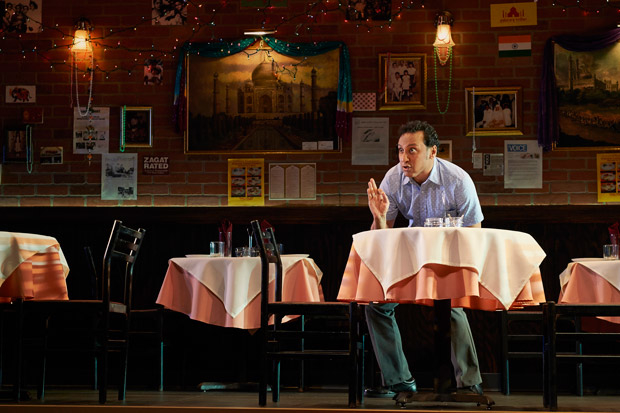Sakina's Restaurant Offers Family Fare With a Dash of Spice
Aasif Mandvi brings his 1998 solo show about an Indian-American family back to NYC.

(© Lisa Berg)
Sakina's Restaurant premiered off-Broadway in 1998 — a cultural moment between the Spice Girls and 9/11. Two decades and one travel ban later, former Daily Show correspondent Aasif Mandvi brings his solo show about a family of Indian immigrants back to New York. Its topicality, at a time when people of color in the United States are scapegoated for everything from terrorism to taking away jobs, is obvious. Yet the play, now running at the Minetta Lane Theatre, focuses on the personal rather than the political — and in that respect, it's barely aged at all.
The family in question is made up of four members, all brought to life by Mandvi. There's Hakim, a restaurant owner who moved to the United States with his wife, Farrida, so that their children could have "all the advantages" of growing up "in the richest country in the world." The main advantage in the eyes of their son, Samir, is the Game Boy that he's constantly playing. As for their daughter, Sakina, after whom Hakim has named his East Village eatery, she takes too much advantage of her surroundings for his taste. Rather than settle down with the man to whom he and Farrida betrothed her at age 11, she insists on "run[ning] around with American boys" as a teenager. Her eventual fiancé, a devout Muslim med student named Ali picked out by her parents, is also incarnated by Mandvi, as is Azgi, a family friend who comes from India to work at the restaurant.

(© Lisa Berg)
With the exception of Azgi, who serves as a recurring narrator figure, each character gets a single monologue in which to bare his or her soul. Curiously, Mandvi is most convincing when playing characters furthest from him in age and gender. As Farrida, who gave up her dream of being an Indian classical dancer to accompany her husband to a country where she sits inside all day, Mandvi exudes passion and bitterness, the first while dancing privately at home and the second while berating her husband when he walks in on her. His Sakina quivers with the teenage agonies of embarrassment at her weird parents and insults from classmates, while his Samir is a pitch-perfect American brat, furious that the family is taking a trip to India instead of Disney World.
During the weaker monologues, though, the holes in Mandvi's solo approach appear. His characters are usually speaking to someone else, which leaves you feeling like you're listening to one end of a phone conversation. If Sakina's Restaurant were an ensemble piece, some of the unseen characters would make more of an impression, like Azgi's mother and the prostitute Ali abashedly visits.
What the one-man format does allow Mandvi and director Kimberly Senior to do, however, is paint a family portrait. Mandvi's collage of characters resemble one another in the way that families do. Costume designer Jen Caprio plays up this resemblance with a light-touch aesthetic, signaling identity changes through just one or two items (a flowing scarf for Farrida, a backward baseball cap for Samir) rather than whole new outfits. Wilson Chin's set, a restaurant interior festooned with multicolored Christmas lights and a painting of the Taj Mahal, is a perfect backdrop for this story of clashing cultures. Similarly, sound designer Jill BC Du Boff underscores scene transitions with Indian music and Top 40 hits from John Mellencamp to, yes, the Spice Girls.

(© Lisa Berg)
Above all, Sakina's Restaurant succeeds on its own terms. As Hakim tells Azgi, "Success is like a mountain. From far away it is inspiring, but when you get close, you realize that it is simply made of earth and dirt and rocks, piled one on top of the other until it touches the sky." Mandvi and Senior have assembled a mountain of stories, characters, and dreams. Even though cracks show here and there, their work is still impressive when viewed as a whole.








